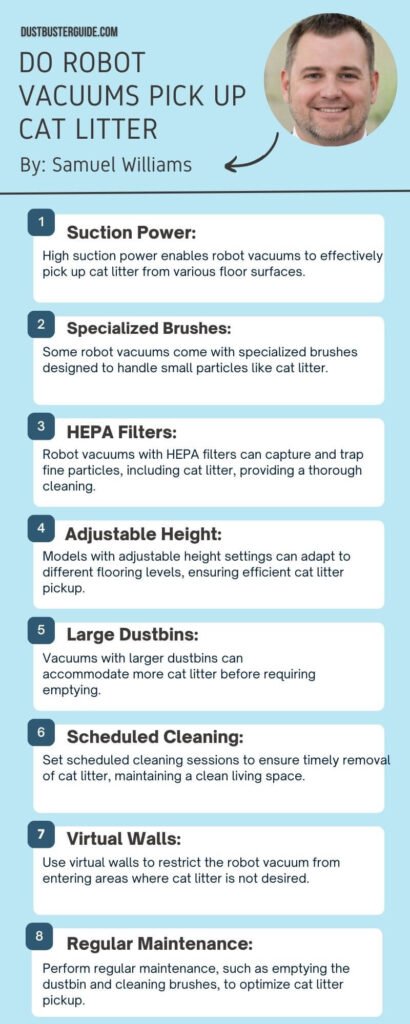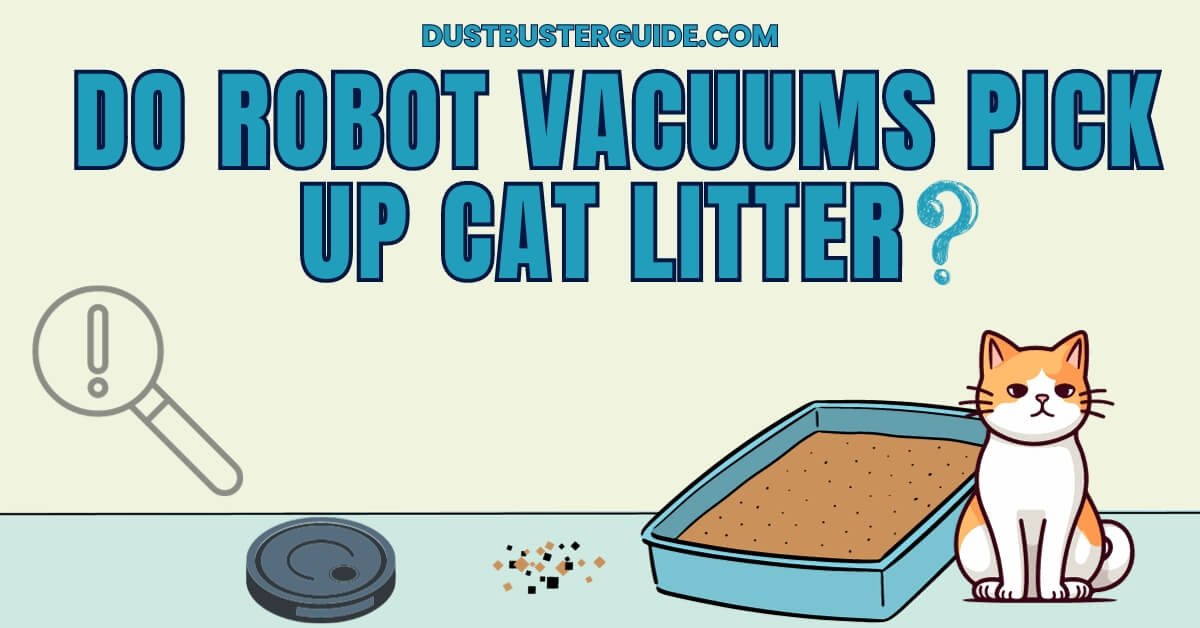The daily cat-tastrophe prompts a question of cleanliness: do robot vacuums pick up cat litter? It’s an exploration into the capabilities of your automated cleaning ally when faced with the feline aftermath.
Picture this: scattered cat litter creating a mess, and the question arises. In just a couple of lines, the answer sweeps in like a cleaning revelation: Yes, many robot vacuums are designed to efficiently pick up cat litter, saving you from the daily dance of sweeping and ensuring your floors stay pristine.
But before you assume it’s a magical solution, join us on this exploration. We’ll discuss considerations for choosing a robot vacuum that conquers the cat litter challenge.
How Do Robot Vacuums Pick Up Cat Litter
Robot vacuums are designed to autonomously clean your floors, saving you time and effort. They navigate around your home using sensors and algorithms to avoid obstacles and map out the most efficient cleaning path. These devices use brushes and suction power to pick up dirt, debris, and even pet hair.
But what about cat litter? Well, that can be a bit trickier for robot vacuums to handle. Cat litter is often small, granular, and lightweight, making it more challenging for the vacuum to effectively pick up. Additionally, the clumping nature of some cat litter can cause them to get stuck in the vacuum’s brushes or clog the suction mechanism.
So, while robot vacuums can certainly help with general cleaning tasks, they may struggle with cat litter. But fear not, there are some features and tips that can help improve their effectiveness when it comes to dealing with cat litter.

What Challenges Robot Vacuum Face While Picking Up Cat Litter
Cat litter presents unique challenges for robot vacuums due to its small size and tendency to scatter. Unlike larger debris, such as dirt or crumbs, cat litter granules can easily get trapped in the brushes and filters of a robot vacuum, causing them to clog and potentially damage the machine. Moreover, the lightweight nature of cat litter makes it prone to being kicked up and scattered across the floor, creating a bigger mess for the robot vacuum to handle.
These challenges can frustrate pet owners who are looking for a convenient way to keep their homes clean while owning a cat.
To better understand the difficulties robot vacuums face when dealing with cat litter, let’s take a look at a comparison table:
| Challenge | Explanation | Solution |
| Clogging | Cat litter granules can clog the brushes and filters of a robot vacuum, hindering its cleaning performance. | Opt for robot vacuums with specialized brushes designed to handle small particles or those with self-cleaning features. Regular maintenance and cleaning of brushes and filters are also crucial. |
| Scattering | Lightweight cat litter can easily be kicked up and scattered across the floor, making it harder for a robot vacuum to clean effectively. | Consider using a cat litter mat or keeping the litter box in an enclosed area to minimize scattering. Some robot vacuums have stronger suction power or edge cleaning capabilities to tackle scattered litter efficiently. |
| Tracking | Cats may track litter outside the litter box, leading to litter particles being spread throughout the house. | Place a dedicated mat or rug near the litter box to help trap litter particles from your cat’s paws. Regular sweeping or vacuuming of the area around the litter box can also help prevent litter from spreading further. |
By understanding these challenges, you can make informed decisions when choosing a robot vacuum that is better equipped to handle cat litter.
Additionally, implementing certain strategies like using specialized mats or rugs and maintaining cleanliness around the litter box area can further enhance the effectiveness of your robot vacuum in keeping your home free from cat litter.
What Features To Look For In A Robot Vacuum
When it comes to choosing a robot vacuum, there are several features you should look for to ensure it can effectively handle the challenges of cleaning up after your furry friend. Cat litter can be a difficult substance for a robot vacuum to pick up, so it’s important to find a model that is up to the task.
Here are some features to consider:
- Strong suction power: Cat litter can be heavy and dense, so you’ll want a robot vacuum with powerful suction to effectively pick it up. Look for a model with high suction power ratings to ensure it can handle the job.
- Large dustbin capacity: Cat litter can take up a significant amount of space in a vacuum’s dustbin. Opt for a robot vacuum with a large dustbin capacity, so you won’t have to constantly empty it during cleaning sessions.
- Effective filtration system: Cat litter often contains dust and small particles that can be harmful to both you and your pet if they are not properly filtered. Choose a robot vacuum with a high-quality filtration system to ensure that the air in your home remains clean and free from allergens.
- Sturdy brushes: Cat litter can get stuck in the brushes of a robot vacuum, causing it to clog or become less effective. Look for a vacuum with durable and easy-to-clean brushes that can handle the task of picking up cat litter without any issues.
By considering these features when choosing a robot vacuum, you can ensure that it will effectively pick up cat litter and keep your home clean and tidy.
Tips For Using A Robot Vacuum With Cat Litter
To effectively incorporate a robot vacuum into your cleaning routine while dealing with the challenges of cat litter, consider these helpful tips.
First, it’s important to choose a robot vacuum that is specifically designed to handle cat litter. Look for models that have strong suction power and a high-quality filtration system to ensure that the litter is effectively picked up and contained. Some robot vacuums even have special brushes or attachments that are designed to handle litter and prevent it from getting stuck in the vacuum.
Next, consider the placement of your robot vacuum in relation to your cat’s litter box. It’s best to place the vacuum in a central location where it can easily access the litter box and the surrounding area. This will help to ensure that the vacuum can effectively clean up any litter that may be tracked outside of the litter box.
Additionally, it’s a good idea to run the robot vacuum on a regular schedule. This will help to keep your floors clean and minimize the amount of litter that accumulates. You can set a daily or weekly schedule for the vacuum to run, depending on your cat’s litter habits and the amount of traffic in the area.
Lastly, make sure to empty the robot vacuum’s dustbin regularly. Cat litter can be heavy and may fill up the dustbin quickly. By emptying the dustbin regularly, you can prevent the vacuum from becoming clogged and ensure that it continues to pick up litter effectively.
Consider the following table for a quick overview of the tips mentioned above:
| Tips | Description |
| Choose a robot vacuum designed for cat litter | Select a vacuum with strong suction and specialized features for handling cat litter. |
| Place the vacuum in a central location | Position the vacuum in an area where your cat frequents and where litter tends to accumulate. |
| Run the vacuum on a regular schedule | Set up a consistent cleaning schedule to keep the litter area clean. |
| Empty the dustbin regularly | Check and empty the dustbin as needed, especially if it fills up quickly due to cat litter. |
| Monitor the vacuum’s performance | Keep an eye on how well the vacuum handles cat litter and address any issues promptly. |
By following these tips, you can effectively use a robot vacuum to pick up cat litter and keep your floors clean.
What Are Some Pros And Cons Of Using Robot Vacuums For Cat Litter
One of the advantages of using robot vacuums for cat litter is that they’re specifically designed to handle the challenges of cleaning up after your feline friend. These automated cleaning machines are equipped with powerful suction capabilities and advanced sensors that allow them to efficiently pick up cat litter from various surfaces in your home.
They are designed to navigate around obstacles and furniture, ensuring that no spot is left untouched.
With their compact size and maneuverability, robot vacuums can easily reach underneath furniture and into tight corners, where cat litter often accumulates. This means that you no longer have to worry about manually sweeping or vacuuming up the litter yourself.
Another benefit of using robot vacuums for cat litter is the time and effort they can save you. Cleaning up after your cat’s litter box can be a time-consuming and tedious task. However, with a robot vacuum, you can simply set it to clean on a schedule or turn it on when needed, and it’ll take care of the dirty work for you.
This allows you to spend more time enjoying the company of your furry companion rather than constantly cleaning up after them.
Additionally, robot vacuums often have a large dustbin capacity, which means they can collect a significant amount of cat litter before needing to be emptied. This further reduces the frequency of maintenance and ensures that you can go longer without having to manually empty the vacuum.
While there are many advantages to using robot vacuums for cat litter, it’s important to consider some potential drawbacks as well. One of the main concerns is the ability of robot vacuums to handle clumping litter.
Clumping litter can sometimes clog the vacuum’s brushes or filter, leading to reduced performance and the need for more frequent maintenance.
Additionally, some cats may be fearful or anxious around the noise and movement of robot vacuums, which can make it difficult for them to use their litter box comfortably. It’s important to introduce the robot vacuum gradually and monitor your cat’s behavior to ensure they aren’t stressed by its presence.
Lastly, robot vacuums are an investment, and while they can save you time and effort in the long run, they do come with an upfront cost. It’s important to consider your budget and the specific needs of your home before deciding to invest in a robot vacuum for cat litter.
What Are The Alternative Solutions For Dealing With Cat Litter
An alternative solution for dealing with cat litter is using self-cleaning litter boxes that automatically scoop and remove waste, reducing the need for manual cleaning. These high-tech litter boxes have sensors that detect when your cat has finished their business and automatically activate a cleaning cycle.
The waste is then scooped into a separate compartment or flushed away, leaving you with a fresh and clean litter box.
Self-cleaning litter boxes offer several advantages over traditional litter boxes.
Firstly, they save you time and effort by eliminating the need for daily scooping. You don’t have to bend down and scoop out clumps of litter anymore, making the chore much more convenient.
Additionally, self-cleaning litter boxes help to control odors. The automatic scooping system removes waste promptly, preventing any lingering smells from permeating your home. This is especially beneficial if you have multiple cats or live in a small space.
Finally, self-cleaning litter boxes can help reduce the spread of bacteria and germs. The waste is immediately removed from the litter box, minimizing the risk of contamination and promoting a healthier environment for both you and your cat.
While self-cleaning litter boxes are a great alternative for dealing with cat litter, it’s important to note that they may not be suitable for every cat. Some cats may be hesitant to use a self-cleaning litter box due to the noise or motion of the cleaning cycle. It’s important to introduce the litter box gradually and provide positive reinforcement to encourage your cat to use it.
Additionally, self-cleaning litter boxes require regular maintenance and cleaning to ensure they function properly. Despite these considerations, self-cleaning litter boxes can greatly simplify the task of dealing with cat litter and provide a cleaner and more convenient experience for both you and your feline friend.
How Do Cats React To Robot Vacuum

Cats’ reactions to robot vacuums can vary widely. Some cats are curious and may approach the vacuum cautiously, while others may be frightened and hide when it’s in operation. Many cats eventually adapt to the presence of a robot vacuum and may even see it as a source of entertainment or a new territory to explore. It’s essential to observe your cat’s initial reaction and ensure their safety around the vacuum. Gradual exposure and positive reinforcement can help them get used to it over time. Providing a safe and quiet space for them during vacuuming can also ease their anxiety.
Are Robotic Litter Boxes Worth It
Robotic litter boxes can be a convenient and time-saving solution for cat owners, but whether they are worth the investment depends on individual circumstances. According to Good Housekeeping, the Litter-Robot 4 is worth the purchase if you can afford it, as it saves time and provides a more sanitary way of dealing with cat waste.
The Litter-Robot 4 is designed to minimize contact with cat waste, and its app allows for easy monitoring of when to change the litter. However, self-cleaning litter boxes can be expensive, with some models costing over $500, and they may be prone to malfunction and harder to clean than traditional litter boxes.
Therefore, it’s important to consider the cost and benefits of a robotic litter box before making a purchase.
Conclusion
So now you know do robot vacuums pick up cat litter? Using a robot vacuum for cat litter is possible with the right features, but it comes with challenges. Choose a suitable robot vacuum with powerful suction and a large dustbin, and regularly empty the dustbin for optimal performance. Sweep the area before using the vacuum and consider using a mat under the litter box to contain tracking. While it can save time, be aware of potential limitations and explore alternative solutions like self-cleaning litter boxes. In the end, using technology to simplify litter cleanup can help maintain a clean home for you and your cat. Happy cleaning!
FAQs
Can robot vacuums detect and avoid picking up cat litter that is wet or clumped together?
Yes, robot vacuums can detect and avoid picking up wet or clumped cat litter. They are equipped with sensors that allow them to identify and steer clear of any messes on the floor.
Are there any robot vacuums specifically designed to handle cat litter?
Yes, there are robot vacuums specifically designed to handle cat litter. They are equipped with features like strong suction power, specialized brushes, and even self-cleaning capabilities to effectively pick up and dispose of cat litter.
Can a robot vacuum effectively clean cat litter from multiple types of flooring, such as carpet, hardwood, or tiles?
Yes, robot vacuums can effectively clean cat litter from multiple types of flooring, such as carpet, hardwood, or tiles. They are designed to handle various debris and have different cleaning modes for different surfaces.
How often do I need to empty the robot vacuum’s dustbin when cleaning up cat litter?
You’ll need to empty the robot vacuum’s dustbin frequently when cleaning up cat litter. The dustbin fills up quickly due to the weight and volume of the litter, so it’s important to empty it regularly for optimal performance.
Do robot vacuums have any features or settings that can prevent cat litter from being scattered around the house during the cleaning process?
Yes, robot vacuums have features like high-powered suction and brushes that prevent cat litter from being scattered. They are designed to efficiently clean up cat litter without spreading it around the house.
Do robot vacuums pick up cat hair?
Yes, robot vacuums are effective at picking up cat hair. They are equipped with suction and brush mechanisms designed to capture pet hair from various surfaces, including carpets, rugs, and hard floors.
Should you vacuum cat litter?
It’s recommended to avoid vacuuming cat litter as it can damage the vacuum cleaner and clog the filter. Instead, use a broom and dustpan to clean up cat litter, as vacuuming may cause the litter to spread and damage the vacuum.
External Resources
- Consumer Buying Behaviour Of Sustainable Vacuum Cleaners – Consequences For Design And Marketing – ScienceDirect
- The Vacuum Cleaner A History By Carroll Gantz
- Rogue Robotic Vacuum Cleaner Causes $3.5k Worth Of Damage, Tribunal Hears – New Zeland Herald
- The Life And Death Of A Robot Vacuum – TechCrunch

